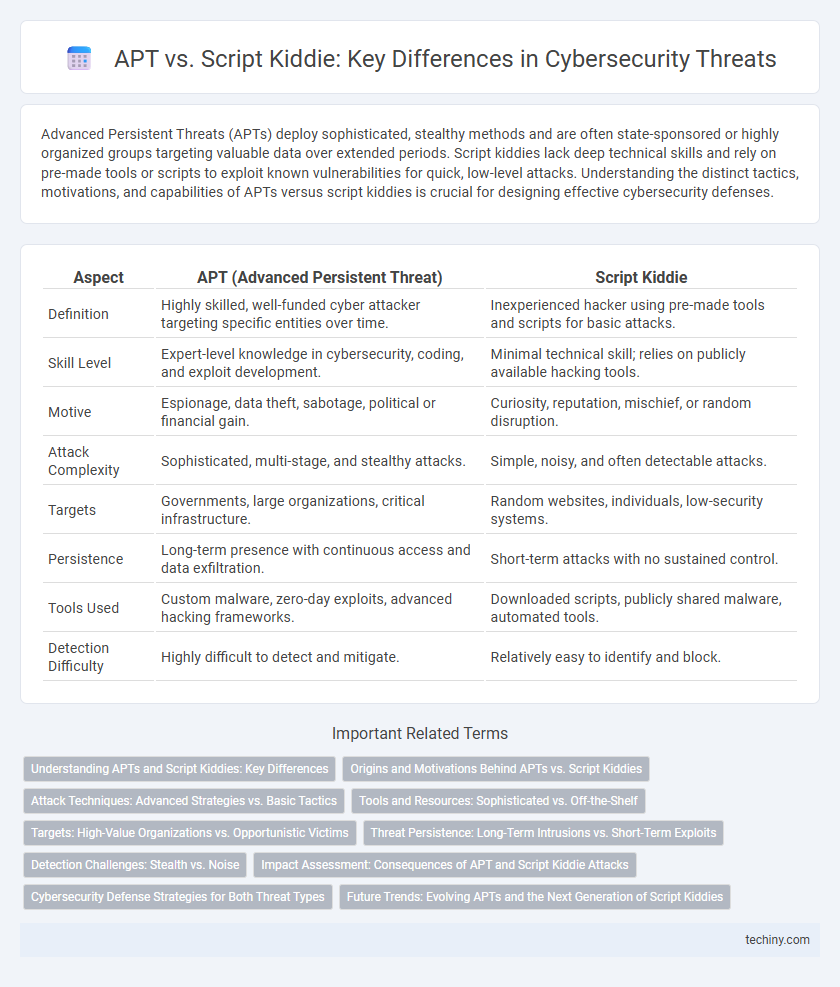Advanced Persistent Threats (APTs) deploy sophisticated, stealthy methods and are often state-sponsored or highly organized groups targeting valuable data over extended periods. Script kiddies lack deep technical skills and rely on pre-made tools or scripts to exploit known vulnerabilities for quick, low-level attacks. Understanding the distinct tactics, motivations, and capabilities of APTs versus script kiddies is crucial for designing effective cybersecurity defenses.
Table of Comparison
| Aspect | APT (Advanced Persistent Threat) | Script Kiddie |
|---|---|---|
| Definition | Highly skilled, well-funded cyber attacker targeting specific entities over time. | Inexperienced hacker using pre-made tools and scripts for basic attacks. |
| Skill Level | Expert-level knowledge in cybersecurity, coding, and exploit development. | Minimal technical skill; relies on publicly available hacking tools. |
| Motive | Espionage, data theft, sabotage, political or financial gain. | Curiosity, reputation, mischief, or random disruption. |
| Attack Complexity | Sophisticated, multi-stage, and stealthy attacks. | Simple, noisy, and often detectable attacks. |
| Targets | Governments, large organizations, critical infrastructure. | Random websites, individuals, low-security systems. |
| Persistence | Long-term presence with continuous access and data exfiltration. | Short-term attacks with no sustained control. |
| Tools Used | Custom malware, zero-day exploits, advanced hacking frameworks. | Downloaded scripts, publicly shared malware, automated tools. |
| Detection Difficulty | Highly difficult to detect and mitigate. | Relatively easy to identify and block. |
Understanding APTs and Script Kiddies: Key Differences
Advanced Persistent Threats (APTs) are sophisticated, well-funded cyber adversaries employing customized malware, extensive reconnaissance, and long-term infiltration to target high-value information assets. Script kiddies lack technical expertise and rely on pre-written scripts or tools to launch opportunistic attacks, typically causing less damage and operating without strategic objectives. Recognizing these distinctions is crucial for developing tailored cybersecurity defenses that address the specific tactics, techniques, and procedures (TTPs) utilized by each threat actor type.
Origins and Motivations Behind APTs vs. Script Kiddies
Advanced Persistent Threats (APTs) originate from well-funded, state-sponsored groups with strategic objectives such as espionage, sabotage, or long-term intelligence gathering. Script kiddies, by contrast, are often inexperienced hackers motivated by curiosity, thrill-seeking, or the desire for notoriety, utilizing readily available tools without deep technical expertise. The stark difference in origins and motivations drives APTs toward sophisticated, targeted cyberattacks, while script kiddies generally execute opportunistic, less complex exploits.
Attack Techniques: Advanced Strategies vs. Basic Tactics
APT groups employ sophisticated attack techniques such as custom malware development, zero-day exploits, and multi-stage intrusion campaigns designed to evade detection and maintain long-term access. In contrast, script kiddies rely on readily available tools and pre-written scripts, leveraging common vulnerabilities without deep technical expertise. The distinction highlights the advanced strategic planning of APTs versus the opportunistic, simplistic tactics of script kiddies in cybersecurity incidents.
Tools and Resources: Sophisticated vs. Off-the-Shelf
APT groups leverage advanced, custom-built tools and zero-day exploits tailored for stealth and persistence, enabling highly targeted cyber espionage and disruption. In contrast, script kiddies rely on readily available, off-the-shelf hacking tools and pre-written scripts with minimal technical expertise, often causing opportunistic attacks with less precision. The sophistication of APT resources significantly enhances attack complexity and evasion, whereas script kiddie tools limit attack scope and effectiveness.
Targets: High-Value Organizations vs. Opportunistic Victims
APT groups specifically target high-value organizations such as government agencies, financial institutions, and critical infrastructure due to the strategic value of the data and long-term access they seek. In contrast, script kiddies attack opportunistic victims with low security defenses, often aiming for quick gains or disruption rather than strategic objectives. The distinction in target selection reflects the varying skill levels and motivations between APT actors and script kiddies.
Threat Persistence: Long-Term Intrusions vs. Short-Term Exploits
Advanced Persistent Threats (APTs) maintain long-term intrusions within targeted networks, utilizing sophisticated techniques to avoid detection and continuously exfiltrate data. Script kiddies engage in short-term exploits, leveraging readily available tools for quick, opportunistic attacks without sustained access or strategic objectives. Threat persistence distinguishes APTs as strategic adversaries focused on prolonged compromise, whereas script kiddies represent transient, lower-level threats.
Detection Challenges: Stealth vs. Noise
Advanced Persistent Threats (APTs) exhibit sophisticated stealth techniques, employing encrypted communications and zero-day exploits that evade traditional detection systems, making them difficult to identify. In contrast, script kiddies generate high noise through repetitive, unsophisticated attacks that trigger numerous alerts, which can overwhelm security analysts but are easier to detect. Effective cybersecurity strategies must differentiate between the subtle, low-noise signals of APTs and the high-noise patterns caused by script kiddies to optimize threat detection and response.
Impact Assessment: Consequences of APT and Script Kiddie Attacks
Advanced Persistent Threats (APTs) cause extensive damage by targeting high-value assets, resulting in prolonged data breaches, intellectual property theft, and significant financial losses. Script kiddie attacks are generally less sophisticated, causing limited disruption, often confined to defacement or minor data theft. The impact of APTs tends to be strategic with long-term consequences, while script kiddie attacks are mostly opportunistic and short-term.
Cybersecurity Defense Strategies for Both Threat Types
Advanced Persistent Threats (APTs) require cybersecurity defense strategies that emphasize continuous monitoring, threat intelligence integration, and multi-layered network segmentation to detect and mitigate sophisticated, stealthy intrusions. Script kiddie attacks demand robust endpoint security solutions, regular software patching, and user awareness training to prevent exploitation of known vulnerabilities through automated tools. Combining behavior-based anomaly detection with strict access controls effectively addresses the distinct tactics and capabilities of both advanced and amateur threat actors.
Future Trends: Evolving APTs and the Next Generation of Script Kiddies
Evolving Advanced Persistent Threats (APTs) will increasingly leverage artificial intelligence and machine learning to conduct highly targeted, persistent cyber espionage campaigns with enhanced stealth and adaptation capabilities. The next generation of script kiddies is expected to exploit more sophisticated automated tools and exploit kits found on the dark web, lowering the barrier to entry and expanding their impact despite limited technical skills. Combining evolving techniques and accessible attack resources will drive new cybersecurity challenges requiring advanced detection and response strategies.
APT vs Script Kiddie Infographic

 techiny.com
techiny.com